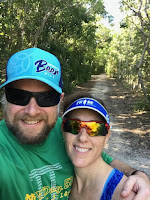Planning My 50 Mile Run
How exactly does one plan for a 50-mile run? Though I have
run many distance events, I’ll be on my feet for much longer than ever. I
anticipate being on the course for about 11-12 hours, give or take. I’ve made a
list of considerations and put a few details in writing. I don’t have it all
together yet, but I know I’m on the right path. Here are some of my plans.
Training plan: After studying many, many different
training plans, I chose a plan from the Runners World book “Run Less
Run Faster” by Bill Pierce, Scott Murr and Ray Moss. I’m using it as a
guideline, not following it as written. This plan includes speed work for
running and drills for biking over the course of 4 running days and 2 biking
days per week. The cornerstone to this plan is back-to-back long run days. I
also do core work, lift weights and continue PT exercises for my weak ankle.
Gear: I have most of the gear that I want to have for
this event, though I am actively looking for better options. I’ll run in Asics
Nimbus and I have 3 pairs in rotation. I have a running backpack with a
bladder, headlamp and plenty of apparel. I’m an ambassador for and plan to wear
XOSKIN compression pants and socks. Race rules require a blinking red light for
the front and back during the night, which will be satisfied by my NOXGEAR vest.
Rules also require reflective gear on all four sides of me. I’ll have to
evaluate my apparel to satisfy this rule.
Nutrition: This is and always will be a moving target.
Running for half a day requires a lot of calories and hydration. I’m an
ambassador for and will be using NUUN Endurance in my backpack bladder and will
carry water. I’m experimenting with running foods, like bars and gels, and real
foods. I’m planning on using a variety of sweet, salty and crunchy foods, as
well as a toothbrush.
Crew: This race offers both crewed and un-crewed
options. I chose crewed so I can have extra food, gear and first aid items in my
husband’s truck. Since this is my first go with the 50-mile distance, I wanted
to identify solutions for all the basic worst-case scenarios. For example, if
it’s raining, I might want to swap out shoes periodically, which I wouldn’t
want to carry. While I don’t anticipate stopping at the truck often, there is a
huge relief knowing that gear is available if I need it.
Recovery Plan: My usual recovery plan includes rest, ice and
heat therapy, compression, hydration and nutrition. I focus on
anti-inflammatory food items, eat extra protein, and hydrate well before and
after long training runs. I work hard to focus on food as fuel, so I increase
or decrease what I eat based on training loads.
Pre- and post-event considerations: This is a
destination event, so my husband and I have to plan for travel and accommodations.
There is a mandatory meeting the day before the race, coinciding with
packet-pickup, that will likely highlight rules for the runner and the crew. I also
anticipate being tired and sore post-race, so I’m thankful to have my husband
there to as we pack up and head home.
Testing apparel, gear and nutrition is essential to
understanding what will work or what to avoid on race day. Anticipating weather
changes, blisters or chaffing, hunger and stomach upset and other race day variables
is important for being prepared. However, I also recognize that I can only
control so much and will be flexible and responsive to situations as they arise.
As I get closer to race day, I will be able to hone in on some of these details
a little better. This is a work in progress and I have a few months of training
ahead of me.




Comments
Post a Comment